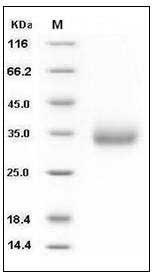-
Product Name
Mouse VSIG4 (His Tag) recombinant protein
- Documents
-
Description
VSIG4 (V-set and immunoglobulin domain containing 4), also known as complement receptor of the immunoglobulin superfamily (CRIg) and Z39Ig, is a type I transmembrane glycoprotein. It is a B7 family-related protein and an Ig superfamily member. In contrast to the B7 family members which contain two IgG domains, VSIG4 contains one complete V-type I g domain and a truncated C-type I g domain. VSIG4 is exclusively expressed on tissue resident macrophages and binds to multimers of C3b and iC3b that are covalently attached to particle surfaces. No VSIG4 expression appears to be present in T and B cells. VSIG4 functions as a negative regulator of T cell activation, and may be involved in the maintenance of peripheral T cell tolerance, and is also identified as a potent suppressor of established inflammation. Mouse VSIG4 is synthesized as a 280 amino acid precursor that contains a signal sequence, an V-type I g domain (aa 36-115), one potential N-linked glycosylation site, and a single transmembrane domain. The V-type I g domain of mouse VSIG4 shares 86% and 80% aa sequence identity with the V-type I g domains of rat and human VSIG4, respectively.
-
Protein name
Protein Vsig4
-
Protein short names
Z39IG; BC025105; RP6-159A1.1; RP23-23B17.3; A530061A11; MGC36211; VSIG4; CRIG
-
Uniprot ID
Q80WA3
-
Gene Name
Vsig4; BC025105
-
Source/Expression Host
Human Cells
-
Expression Plasmid/cDNA
A DNA sequence encoding the extracellular domain (Met 1-Pro 187) of mouse VSIG4 (NP_808457.1) precursor was expressed with a C-terminal polyhistidine tag.
-
Protein Species
Mouse
-
Molecular weight
The recombinant mouse VSIG4 consists of 179 amino acids and has a predicted molecular mass of 20.4 kDa. In SDS-PAGE under reducing conditions, the apparent molecular mass of rmVSIG4 is approximately 35 kDa due to glycosylation.
-
Purity
> 95 % as determined by SDS-PAGE
-
Validations

Mouse VSIG4 Protein (His Tag) SDS-PAGE
Related Products / Services
Please note: All products are "FOR RESEARCH USE ONLY AND ARE NOT INTENDED FOR DIAGNOSTIC OR THERAPEUTIC USE"
